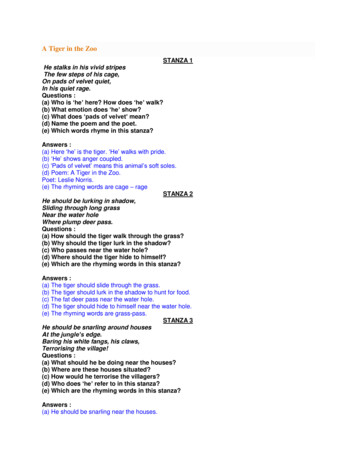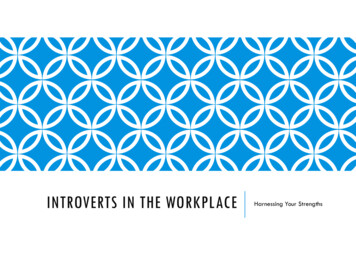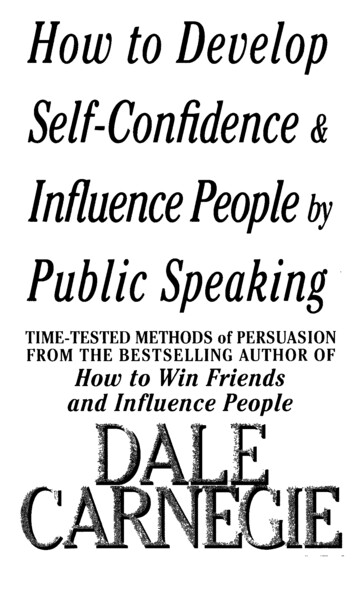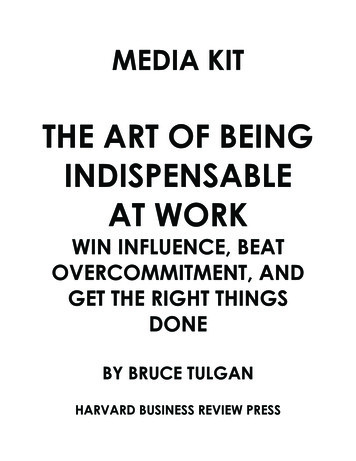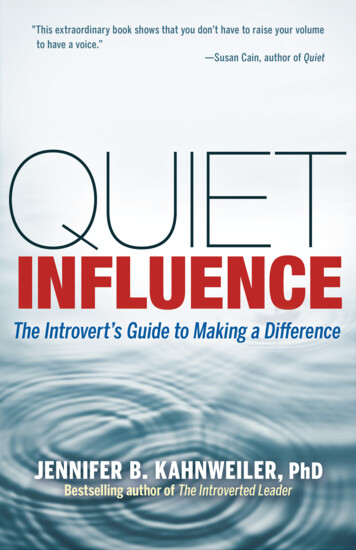
Transcription
QUIETInfluence
Copyright 2013 by Jennifer B. KahnweilerAll rights reserved. No part of this publication may be reproduced, distributed, ortransmitted in any form or by any means, including photocopying, recording, orother electronic or mechanical methods, without the prior written permission of thepublisher, except in the case of brief quotations embodied in critical reviews and certainother noncommercial uses permitted by copyright law. For permission requests, writeto the publisher, addressed “Attention: Permissions Coordinator,” at the address below.Berrett-Koehler Publishers, Inc.235 Montgomery Street, Suite 650San Francisco, CA 94104-2916Tel: (415) 288-0260 Fax: (415) 362-2512 www.bkconnection.comOrdering InformationQuantity sales. Special discounts are available on quantity purchases by corporations,associations, and others. For details, contact the “Special Sales Department” at theBerrett-Koehler address above.Individual sales. Berrett-Koehler publications are available through most bookstores.They can also be ordered directly from Berrett-Koehler:Tel: (800) 929-2929; Fax: (802) 864-7626; www.bkconnection.comOrders for college textbook/course adoption use. Please contact Berrett-Koehler: Tel:(800) 929-2929; Fax: (802) 864-7626.Orders by U.S. trade bookstores and wholesalers. Please contact Ingram PublisherServices, Tel: (800) 509-4887; Fax: (800) 838-1149; E-mail: customer.service@ingrampublisherservices.com; or visit www.ingrampublisherservices.com/Ordering fordetails about electronic ordering.Berrett-Koehler and the BK logo are registered trademarks of Berrett-KoehlerPublishers, Inc.Printed in the United States of AmericaBerrett-Koehler books are printed on long-lasting acid-free paper. When it is available,we choose paper that has been manufactured by environmentally responsible processes.These may include using trees grown in sustainable forests, incorporating recycledpaper, minimizing chlorine in bleaching, or recycling the energy produced at the papermill.Library of Congress Cataloging-in-Publication Data[insert here]First Edition18 17 16 15 14 1310 9 8 7 6 5 4 3 2 1
QUIETInfluenceThe Introvert’s Guide toMaking a DifferenceJennifer B. Kahnweiler, PhD
To Bill, who has quietly influenced meto love him . . . then and now.
ContentsPrefaceIntroduction: Why Quiet Influence, Why Now?OneStop Trying to Act Like an ExtrovertTwoThe Six Strengths of Quiet InfluencersThreeYour Quiet Influence Quotient (QIQ)FourStrength #1: Taking Quiet TimeFiveStrength #2: PreparationSixStrength #3: Engaged ListeningSeven Strength #4: Focused ConversationsEight Strength #5: WritingNineTenStrength # 6: Thoughtful Use of Social MediaMaking a Quiet DifferenceNotesAcknowledgmentsIndexvii
Quiet InfluenceAbout the AuthorWorking with the AuthorYour Quiet Influence Quotient (QIQ)Self-Assessment Productviii
Preface“In every performance review, I’m told I need to speakup more. That I need to spend less time in my office with mydoor closed. My boss says I have to ‘sell’ my ideas with moreenthusiasm. My co-workers say that I need to be more of a‘team player’ and less of a ‘report generator.’ Believe me, I’vetried. It seems that when I try to develop those skills, though,I’m just acting like someone else. I feel as if I have less of animpact rather than more. How can I be me and still make adifference?”Sari sighed and shrugged her shoulders with more thana hint of frustration as she posed the question to me during aworkshop I was leading at her company. I’ve been asked a similar question many times, and I always feel a sense of sorrow inanswering. The reality is that introverts are indeed continuallyasked to adapt to an extrovert-centric workplace that rewardsbeing out there and on stage. Organizational cultures supportthose who talk about their accomplishments, who spend moretime out and about networking instead of alone deep in thought,and who make sure they are the first to get their ideas heard.If you are an introvert, you probably feel as perplexedand underappreciated as Sari. Know that you are not alone andthat there is a solution—one that not only honors who you areix
Quiet Influencebut also dramatically and immediately ramps up your ability tomake a difference at work. Quiet Influence gives you that solution and shows that it resides precisely in the place where you aremost comfortable: deep inside yourself.This book is not about how introverts need to adapt to anoutgoing, extroverted world. Instead, it’s about learning from theQuiet Influencers among us who are making just as much, if notmore, of a difference than their extroverted colleagues.It’s just that they are going about it in such a, well . . . quietway that few seem to notice them. So many books about influence miss the mark, extolling a more extroverted approach thatinvolves winning people over by talking things up, presentinggreat arguments and quickly and aggressively convincing othersto do what they want them to do.Over my years of working with introverted professionalsand studying the process of influence, I have become convincedthat introverts can be highly effective influencers when they stoptrying to act like extroverts and instead make the most of theirnatural, quiet strengths.Because you’ve probably tried the extroverted methods, whynot take a walk on the quiet side? You can become a more effective influencer when you tap into your natural strengths, and inthe pages that follow I’m going to show you how. You’ll recognizeyour strengths and learn ways to enhance and magnify them.You will deepen your understanding of how introverts like yousucceed at influence. If you are open to building on your naturalstrengths through conscious practice, you will perfect core skills,develop heightened sensibilities, and bump up your confidence toinfluence all kinds of people and situations. As a result, you willgreatly enhance your influencing success rate by embracing analternative to traditionally western Type A view of interactions.Perhaps you land more on the extroverted side of the lineas someone energized by people and the outside world. Why nottake a walk on the quiet side? Through this book, you will deepenx
Prefaceyour understanding of how introverts succeed at influence.You will find that learning from introverts offers an enlightening opportunity to balance out your own (likely louder) ways ofinfluencing. If you are open to experimenting with a differentside of yourself, you will greatly enhance your own influencingportfolio so that you can have a bigger impact in a wider varietyof situations. You’ll get noticed precisely because you are tryingsomething new.xi
IntroductionWhy Quiet Influence, Why Now?Do you work in a company? How about in a nonprofit thatcompetes for funding?Do you work in a government agency with contractors?Are you an entrepreneur or freelancer who sells products orservices?Are you in technology, engineering, and science?Do you work in sales, marketing, project management,teaching, medicine, the law, human resources, oradministration?The truth is that everyone in a professional role needs toinfluence others. From Seoul to Seattle, today’s competitiveworkplace demands that you influence a variety of situations andpeople, not once in a while but multiple times a day. Althoughinfluence is sometimes about really big issues and opportunities,it is also about nudging change along one small step at a time.Noted researchers such as Jay Conger (“The Necessary Artof Persuasion”) have found that selling ideas and getting peopleon board is a process, not an event.1 Influence is not about getting people to come to see things your way but about learning1
Quiet Influencefrom others and negotiating a shared solution. This approach iswell suited to the introvert temperament. It involves patience,planning, and perseverance. If we all think that the only way toget things done is to shout louder and louder and take up morecenter-stage space, we’ll miss the opportunities to listen, learn,and respond thoughtfully.It may be that our society is starting to get this message.Extroverts are slowly (very slowly, some argue) realizing that westand to lose the wisdom and contributions of more than half ofthe population if we don’t listen to the introverts in our world.Since the 2009 publication of my last book, The IntrovertedLeader: Building on Your Quiet Strength (the first book aboutintroverted leaders), a firestorm of other books (including SusanCain’s 2012 New York Times best seller Quiet), articles and socialmedia have crusaded for the cause of introverts. I have been gratified to hear the buzz of such conversations everywhere.Moreover, even though they will never really experiencehow an introvert truly feels, extroverts are starting to get the differences on a personal level. They push their pens in my hand tosign a copy of The Introverted Leader for their sons, spouses, andsiblings, who they never quite understood. Hope for a broaderchange springs from such a personal connection.Perhaps the strongest driver for Quiet Influence, however,is how it can contribute to success in today’s shifting workplace.These trends indicate that the time for Quiet Influence is now:1. Flattened organizations and complex vendor/supplier/customer interactions mean that you must, no matter your positionor personality type, be effective at getting your ideas heard. Goneare the days when you can rely on a boss or your boss’s boss tomake your case for you. You have to establish critical relationships and communicate your key messages yourself.2. Going global means that you need to find multiple ways toinfluence an increasingly diverse set of colleagues and customers.2
Introduction: Why Quiet Influence, Why Now?For example, your more reflective, low-key influencing approachwill be much more effective in Asia with your colleagues than thetraditional extroverted one. You can use your Quiet Influenceskills to make a difference with those in cultures that value a quieter approach.3. The virtual world is evolving and ever present. In today’ssociety, it’s highly unlikely that you can influence a broad groupof people without using digital media in purposeful ways. Introverts, as particularly thoughtful users of social media, may wellbe ahead of the game. They have been drawn to social mediabecause it lets them use their strengths and better manage theircommunication. You and other Quiet Influencers who havealready invested in learning and using social media are poisedto effect tomorrow’s change more quickly than influencers whohave ignored these technologies.4. Heightened competition for business and jobs means thatcompanies are seeking suppliers and employees who bring fresh,innovative approaches. The truth is extrovert-centric self-promotion and loud persuasion are passé. Today, you will stand outfrom the crowd if you have a knack for building up others andare committed to listening instead of talking.Because Quiet Influence is already what you do naturally,these trends offer you the impetus to enhance those skills. Yourtime has come. This book is written to help you and millions ofother introverts recognize, develop, and highlight your innateinfluencing strengths. Together, you make up about 50 percentof the world’s population, and you can make a big difference inorganizations and communities around the world. I encourageyou to applaud the success of your strengths and practice makinga difference without making a lot of noise.I believe that as these trends intensify, the tide will turnand extroverts will want to learn Quiet Influencing strengths3
Quiet Influencefrom the introverts they know. Many extroverts recognize thatthey are more effective, flexible, adaptable influencers when theirinfluencing toolbox includes a wider variety of approaches.I’ll admit it: I am one such extrovert. I needed to practicehow to make a difference without making a lot of noise. For muchof my professional life, I went along with the ill-founded belief thatthe Type A approach, with its emphasis on talking and findingcenter stage, delivered results. I am a speaker, executive coach, andauthor whose job it is to influence people to try new approachesin their lives. Of course, I thought, that means being “out there”and being “on.” I moved very fast, did a lot of winging it, and oftenfound a way to take center stage. As I progressed in my career, Iembodied the stereotype of the loud, assertive New Yorker I was.Yet I grew up quietly watching people. My dad, AlvinBoretz, was a TV and film screenwriter, and many of our dinnerconversations were about people, their motivations and behavior. Because Dad’s work depended on picking up the nuances ofdialogue, the meanings of conversations were of endless interestto our family. It was not unusual to see my extroverted familyof four sitting quietly in Cairo’s, our local Italian restaurant,listening to simultaneous conversations around us. On the wayhome, we would share dialogues we overheard and wonder aloudabout the lives and relationships of our fellow diners. The introverts offered few verbal clues, so we had a field day guessing whatcould have been going on in their lives. Those quieter, low-keyfamilies, so different from ours, were especially intriguing to me.What was going on with them?I embarked on my career and continued to be an observerof introverts. I was still people watching, but this time, the peoplewho intrigued me were the introverts who sometimes struggledin leadership positions even though they had all the power theyneeded deep inside. I wrote The Introverted Leader: Buildingon Your Quiet Strength to give these talented people a guide forbeing in charge while being themselves.4
Introduction: Why Quiet Influence, Why Now?During the research for that book and in countless interactions since its publication, I have found myself increasingly drawnto the stories and experiences of introverts. The more I speak with,listen to, coach, and write about introverts, the more I appreciate their sensibility. I have realized that the quiet language of theintrovert is refreshingly different from my natural outgoing persona, and I recognize that I can incorporate introverted traits andbehaviors in order to have a greater impact. For instance, insteadof rushing on to that conference call at the last minute, I can spendsome quiet time sitting on my deck watching the trees and reflecting on my purpose for the day. Or in lieu of randomly postingsomething on Facebook, I can think of the other tasks that awaitme. Or in working through a sticky relationship, I can write outmy thoughts to gain clarity on where I stand.All in all, I recognize that a powerful shift occurs in mewhen I flow into the less prominent side of my personality. WhenI choose to embrace my internal energy, I gain deeper insights,delve into my creativity, and become more centered. Jungian psychologists would say that I am releasing a potent force by tappinginto the less dominant side of my temperament. I simply see thatI have been influenced by the introverts I set out to influence.Inspired by the Quiet Influencers I have met and the effectthey had on me, I turned my attention to the question of howthese successful introverts make a difference. How exactly dothey challenge the status quo, provoke new ways of thinking, orinspire others to move forward? What inner strengths do theycall upon to effect change? What steps do they take to influenceothers?In my professional life, I have interacted with thousands ofpeople who deepened my knowledge of the introvert experienceand gave me ideas about how to answer these questions. Classdiscussions, questions after speeches, and problems in coachingsessions have all contributed to my understanding and perspective. In my role as an author and journalist, I met a wide range of5
Quiet Influenceintroverts and have written and been interviewed for a number ofarticles on the topic of introverts in the workplace for publicationssuch as Forbes, Bloomberg Business Week, and the Wall Street Journal. Through hallway conversations, follow-up emails, and blogcomments, I have gained an even deeper understanding about howintroverts experience their world and the ways in which they usetheir natural strengths to get through to people in powerful ways.I have also been fortunate to be plugged into a vibrant community of Quiet Influencers. I specifically asked these professionals from a wide range of fields and organizations about theirapproach to influence. They often provided written responses,and I followed up with phone interviews to enhance my understanding. In their characteristically humble way, they sharedabout the myriad ways in which they make a difference withother people and organizations. As privacy-valuing introverts,several of these Quiet Influencers asked that their names notbe used. In those cases, I have replaced their name with a firstname only pseudonym. Many others agreed that I could use theirnames, and I have included those in the text.I have done my best to capture the stories that motivatedme as I sought to answer my driving question: how do they makean impact by building on their natural, quiet strengths? I thendistilled their answers into the six strengths you will read aboutin the chapters ahead. In these strengths, I hope you find yourown unique expression of Quiet Influence.6
Chapter 1Stop Trying to Act Likean Extrovert“Lower your voice and strengthen your argument.”Barbara McAfee, Author and SingerDid you know that . . .The best ideas often emerge in the depths of solitude?Writing a persuasive email can move a project along fasterthan a standard conversation?Listening for what is not said is more important thanlistening for what is?Quiet Influencers—those people who make things happenwithout in-your-face techniques—learned these lessons throughexperience. Like ripples in a pond they deliver a big impact without making a loud fuss. When introverts need to be influencers, they focus on careful thought and depth. There isn’t muchfanfare or much noise. In their quiet, humble way, introvertedinfluencers make sure that the people they are hoping to impactget the message. Yet they are frequently overlooked and underestimated by organizations and colleagues who buy into the ideathat talking reigns supreme.7
Quiet InfluenceIf you are an introvert, chances are that you’ve tried to influence others by mirroring your more outgoing colleagues. My guessis that such an approach isn’t working for you: it’s exhausting,unsustainable, and ultimately ineffective. Contrary to what mostbooks on influence will tell you, the answer isn’t about becomingthe extrovert you aren’t. I submit, however, that you will become amore effective influencer when you stop trying to act like an extrovert and instead make the most of your natural, quiet strengths. Bysharing specific stories and tips from successful Quiet Influencers,this book will show you how to identify, magnify, and apply thosenatural strengths so that you can make a big difference withoutmaking a lot of noise. You will discover how you can acknowledgeyour internal energy, tap into its wisdom, and thoughtfully engagewith the outside world.The Roadblocks to Quiet InfluenceCertainly, the louder extroverted approach dominates the workplace today. That approach, which negates the natural tendenciesof more than half of the population, sets up roadblocks to QuietInfluence. Do any of these roadblocks resonate with you?1. Focus on TeamsBack in the 1980s, corporations jumped on the teams-produceresults bandwagon, and the group approach proliferated, bringing us today’s reality: professional work most often necessitatesteam work. Your supervisor may be called your “team leader,”and your work group is likely called a “team.” Our workstationsare arranged so that we can sit with our teams, we do most of ourwork in “team meetings,” we generate ideas through brainstorming, we strive to meet team objectives, and most people are nothired until they have interviewed with all members of the team.For introverts, this team-heavy approach presents a problem. Notonly does being intertwined with others deplete their reserves8
Chapter 1: Stop Trying to Act Like an Extrovertof people energy, it also takes them away from the physical andintellectual space, where they do their best thinking. If you arean introvert, you know that need to be alone to reflect and create.There is so much pressure that introverts write about escaping to“bathroom solitude.” In fact, in a survey I conducted of one hundred introverts, four out of five said they “suffered from peopleexhaustion.”2 With this pressure to be engaged with people allday, Quiet Influencers have a hard time finding the quiet timeand preparation to hatch their plans.2. The Need to Talk about Accomplishments and IdeasIn most organizations, sharing your accomplishments contributes to your personal “brand.” People come to know youand appreciate the value you offer because you’ve talked aboutyourself and what you’ve done. The problem is that those folkswho don’t “brag on themselves” (i.e., most introverts) often findthemselves unwittingly out of the loop. If they don’t have a bosswho seeks their input, showcases their talent, and enhances theirvisibility, they are often left behind. Today’s corporate culturesdo not reward humility. This characteristic restraing often translates into being overlooked. Introverts often have great ideas thatgo unheard. In group settings, they may show up with smartsolutions, yet can’t seem to find an opening in which to sharethem. Even in one-on-one conversations—especially with extroverts—they have trouble interjecting their ideas and being heard.Because these quiet people haven’t talked themselves up, theytend to fly under the radar, and few extroverted colleagues thinkto draw them out to share their ideas. The introvert thereforefinds it difficult to get people’s attention and use that attention toinfluence situations.3. The Pressure to Act ExtrovertedMany Asian cultures deeply value the ability to not showmuch emotion. Western workplaces, however, barely tolerate9
Quiet Influenceexpressionless faces or quiet people. It seems that to fit in, youhave to be animated and verbal. Not your style? Too bad. To succeed, you have to fake it.Oliver Goldsmith, the 18th-century Irish writer, describeda character by saying, “On the stage he was natural, simple, andaffecting. ‘Twas only when he was off, he was acting.” Introvertsoften express a similar feeling. They “act the part” of being happy,sociable, and expressive even when they are feeling quite different. Susan Cain, the author of Quiet, refers to this pressure as living up to the “Extrovert Ideal.”3 One Quiet Influencer describessmall talk at business events as the sounds of “competitive egos.”When she joins in she feels inauthentic.Yet challenging the status quo and inspiring others tomove forward takes a willingness to show your real self to others. Introverts find their influencing efforts impeded when otherssense they are difficult to read and when they are exhausted bythe pressure to be “on.”4. Making Quick DecisionsFrom answering a question in a meeting to responding to anovernight email from a customer, today’s environment pressurespeople to make quick decisions. Many workplaces value instantresponses over well-thought-out ones that take a little longer.The speed of technology and an increasingly competitive globalclimate have revved up the pace of work. The time to ponder asticky problem from various angles has evaporated. The “what if”questions and the chance to go back to gather more data beforedeciding are gone. The people we are trying to sell our ideas andproducts to want results now.Unfortunately, introverts once again get the short end of thedeal. They are frustrated when they are unable to slow down thedecision-making process. They are not able to take the needed timeto process decisions in their head and do the necessary preparation to yield the best results. Others then often label them as “slow”10
Chapter 1: Stop Trying to Act Like an Extrovertand, behind the curve and they find it difficult to be treated withthe respect they deserve. While they are pondering decisions andanalyzing the situation, they often fail to pick up the cues fromothers that they are about to be left behind. Their “delay” oftencosts them the opportunities to influence the decision.5. Lowered Privacy BoundariesSimilar to unwanted probing at social events, social media siteslike Face book pile on the pressure for us to open up our innerselves to the outer world. The lower privacy boundaries createan uncomfortable climate for introverts, who like to get to knowsomeone before baring their soul. They contend with the notionof TMI (too much information) on a daily basis.Savvy introverts know they need to build relationships toinfluence others. They simply want to get to know people slowlyinstead of jumping right to the personal stuff. The pressure toshare and connect every day at an accelerated pace stresses themout, depletes their energy, and challenges the very relationshipsthey are seeking to build on their own terms.6. Being Talked OverOf all the roadblocks to Quiet Influence, being talked over is theone that seems to frustrate introverts the most. In the talkativeclimate of Western society, interruptions abound. If an introvertspeaks quietly or takes a pause, others jump in and steal the stage.Even if an introvert is speaking at a normal volume, eloquentlyexpressing an idea he or she has fully developed before offeringit, extroverts are likely to interrupt. To the extrovert who tends tothink out loud, the interruption is merely a way of building off ofthe introvert’s good idea. To the introvert, the interruption is like ablanket that silences his or her voice. Introverts’ ideas cease to beexplored by the group, and they tend to surrender to the opinionsof the loudest person in the room. The result: introverts are demotivated and less inclined to float new ideas.11
Quiet InfluenceMoreover, introverts feel pressure to participate in the interruption game. Many introverts from Asia comment that they heartwo competing voices in their head: their parents saying “be polite”and their boss telling them they need to “speak up” and interject their comments in meetings. This instruction creates a deepconflict for introverts who prefer to finish and marinate in theirthoughts, taking advantage of a pause in the conversation not tospeak, but to think. Not only do they face the frustration of beingtalked over, but they are encouraged to impose that frustration onothers in a way that fights with their very nature.If these roadblocks sound familiar to you and invoke feelings offrustration, know you are not alone. You are simply an introvertstuck in an extrovert-centric world. Instead of trying to avoidthese roadblocks on the extrovert highway, take a more direct,efficient, and enjoyable route. Embrace what you do naturallyand see greater results. Other introverts have done it: they are outthere delivering the next possible cure for cancer, the answer toglobal warming, and the fix for education. You can do it too.Characteristics that Shape IntrovertsSo you’re getting the message that you don’t have to be an extrovert to be a great influencer. You can succeed by embracing yourintroverted nature. But what does the term introvert really mean?It’s a term many people throw around these days but few peoplereally understand.Let’s start with a fundamental question: When you need torecharge, do you tend to want to be alone in a quiet place? If youanswered yes, you’re likely an introvert.Technically speaking, introversion and extroversion areterms that refer to personality traits and are about sources ofstimulation and energy. Although extroverts recharge by beingwith people and participating in high-energy events, their12
Chapter One: Stop Trying to Act Like an Extrovertintroverted counterparts draw energy from within. Just to clarify: shyness is different than introversion. Shyness is a product offear or anxiety in social settings, whereas introversion is simplyabout a source of energy.This basic tendency to find energy from within comes outin these observable characteristics of introverts. See if any ofthese resonate with you:Embrace solitude Introverts need and want to spend time alone.At work, they prefer quiet, private spaces and like to handle projects on their own or in small groups.Think first, talk later Introverts think before they speak. Even incasual conversations, they consider others’ comments carefullyand stop and reflect before responding. They know how to usethe power of the pause.Hold emotions inside Introverts are seldom outwardly emotional or expressive. They can be difficult to read and thus theirfeelings are frequently misconstrued.Focus on depth Introverts seek depth over breadth. They like todig deep—delving into issues and ideas before moving on to newones. They are drawn to meaningful conversations as opposed tosuperficial chitchat. They know when to tune into others and whenthey don’t need to spend so much energy doing so.Let their fingers do the talking Introverts prefer writing to talking. On the job, they opt for email over the telephone and arelikely to prefer writing reports over giving presentations.Act low-key Introverts are usually quiet and reserved. They tendto speak softly and slowly. They have no desire to be the centerof attention, preferring instead to fly below the radar. Even inheated conversations, they tend to project calm on the outside.Keep private matters . . . private Introverts are anti-”open book.”They keep personal matters under wraps, sharing informationwith only a select few; even then, only after they know those13
Quiet Influencepeople well and feel a level of comfort with them. They can beequally cautious about work matters
Leader: Building on Your Quiet Strength (the first book about introverted leaders), a firestorm of other books (including Susan Cain’s 2012 New York Times best seller Quiet), articles and social media have crusaded for the cause of introverts. I have been grat

